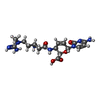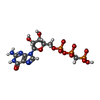+Search query
-Structure paper
| Title | Blasticidin S inhibits mammalian translation and enhances production of protein encoded by nonsense mRNA. |
|---|---|
| Journal, issue, pages | Nucleic Acids Res, Vol. 49, Issue 13, Page 7665-7679, Year 2021 |
| Publish date | Jul 21, 2021 |
 Authors Authors | Kyle T Powers / Flint Stevenson-Jones / Sathish K N Yadav / Beate Amthor / Joshua C Bufton / Ufuk Borucu / Dakang Shen / Jonas P Becker / Daria Lavysh / Matthias W Hentze / Andreas E Kulozik / Gabriele Neu-Yilik / Christiane Schaffitzel /   |
| PubMed Abstract | Deciphering translation is of paramount importance for the understanding of many diseases, and antibiotics played a pivotal role in this endeavour. Blasticidin S (BlaS) targets translation by binding ...Deciphering translation is of paramount importance for the understanding of many diseases, and antibiotics played a pivotal role in this endeavour. Blasticidin S (BlaS) targets translation by binding to the peptidyl transferase center of the large ribosomal subunit. Using biochemical, structural and cellular approaches, we show here that BlaS inhibits both translation elongation and termination in Mammalia. Bound to mammalian terminating ribosomes, BlaS distorts the 3'CCA tail of the P-site tRNA to a larger extent than previously reported for bacterial ribosomes, thus delaying both, peptide bond formation and peptidyl-tRNA hydrolysis. While BlaS does not inhibit stop codon recognition by the eukaryotic release factor 1 (eRF1), it interferes with eRF1's accommodation into the peptidyl transferase center and subsequent peptide release. In human cells, BlaS inhibits nonsense-mediated mRNA decay and, at subinhibitory concentrations, modulates translation dynamics at premature termination codons leading to enhanced protein production. |
 External links External links |  Nucleic Acids Res / Nucleic Acids Res /  PubMed:34157102 / PubMed:34157102 /  PubMed Central PubMed Central |
| Methods | EM (single particle) |
| Resolution | 3.13 - 4.1 Å |
| Structure data | EMDB-12631, PDB-7nwg: EMDB-12632, PDB-7nwh: EMDB-12633, PDB-7nwi: |
| Chemicals |  ChemComp-MG:  ChemComp-BLS:  ChemComp-ZN:  ChemComp-GCP: |
| Source |
|
 Keywords Keywords |  RIBOSOME / Inhibitor 80S Termination Complex Blasticidin S Translation NMD RIBOSOME / Inhibitor 80S Termination Complex Blasticidin S Translation NMD |
 Movie
Movie Controller
Controller Structure viewers
Structure viewers About Yorodumi Papers
About Yorodumi Papers










